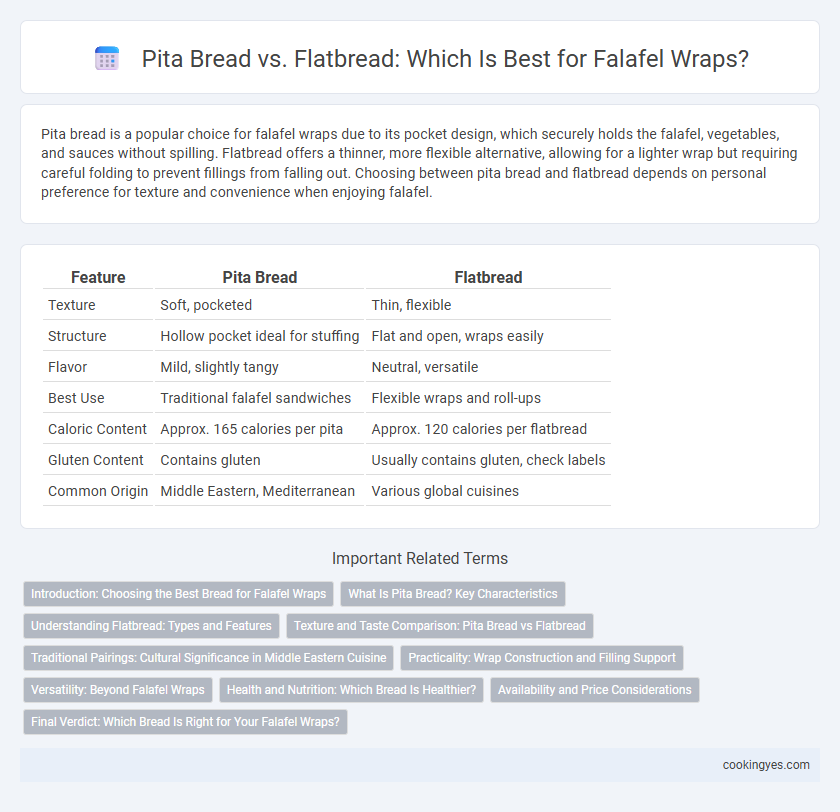Pita bread is a popular choice for falafel wraps due to its pocket design, which securely holds the falafel, vegetables, and sauces without spilling. Flatbread offers a thinner, more flexible alternative, allowing for a lighter wrap but requiring careful folding to prevent fillings from falling out. Choosing between pita bread and flatbread depends on personal preference for texture and convenience when enjoying falafel.
Table of Comparison
| Feature | Pita Bread | Flatbread |
|---|---|---|
| Texture | Soft, pocketed | Thin, flexible |
| Structure | Hollow pocket ideal for stuffing | Flat and open, wraps easily |
| Flavor | Mild, slightly tangy | Neutral, versatile |
| Best Use | Traditional falafel sandwiches | Flexible wraps and roll-ups |
| Caloric Content | Approx. 165 calories per pita | Approx. 120 calories per flatbread |
| Gluten Content | Contains gluten | Usually contains gluten, check labels |
| Common Origin | Middle Eastern, Mediterranean | Various global cuisines |
Introduction: Choosing the Best Bread for Falafel Wraps
Pita bread offers a pocket-like structure that holds falafel and toppings securely, enhancing the traditional Middle Eastern eating experience. Flatbread, with its soft and flexible texture, allows for a fully wrapped falafel, making it easier to eat on the go. Both breads complement falafel's crispy texture, but pita is preferred for its convenience while flatbread offers versatility in wrap size and ingredient combinations.
What Is Pita Bread? Key Characteristics
Pita bread is a type of round, slightly leavened flatbread known for its distinctive pocket that forms during baking, perfect for stuffing with falafel and other fillings. It is soft yet sturdy, made primarily from wheat flour, water, yeast, and salt, providing a chewy texture that holds ingredients securely. This pocket feature differentiates pita from other flatbreads, making it an ideal vessel for falafel wraps, allowing easy layering of vegetables, sauces, and falafel balls without spillage.
Understanding Flatbread: Types and Features
Flatbread varieties such as laffa, chapati, and tortilla offer diverse textures and thicknesses that influence falafel wrap experience by providing flexible, softer layers compared to the pocket structure of pita bread. Laffa bread, with its pliable, slightly chewy consistency, absorbs tahini and salad dressings well, preventing leakage and enhancing flavor integration in falafel wraps. Choosing flatbread types depends on preferences for softness, flexibility, and how well the bread complements falafel fillings without overwhelming them.
Texture and Taste Comparison: Pita Bread vs Flatbread
Pita bread offers a soft, slightly chewy texture with a pocket that perfectly holds falafel, enhancing the overall eating experience by keeping ingredients neatly contained. Flatbread provides a thinner, more flexible base with a mild, slightly toasted flavor that allows the falafel's spices to stand out more prominently. Choosing pita bread results in a more structured wrap with a balanced flavor, while flatbread delivers a lighter bite with greater emphasis on the falafel's taste.
Traditional Pairings: Cultural Significance in Middle Eastern Cuisine
Pita bread, characterized by its pocket structure, is the traditional and preferred choice for falafel wraps in Middle Eastern cuisine, offering a convenient vessel that holds fillings without spillage. Flatbread, although also used, lacks the pocket feature, making it less practical for containing falafel and accompaniments, but it carries regional significance in certain cultural variations. The pairing of falafel with pita highlights historical culinary practices rooted in Levantine culture, reflecting both functional design and cultural identity in food preparation.
Practicality: Wrap Construction and Filling Support
Pita bread's pocket structure offers superior practicality for falafel wraps by securely containing the fillings and minimizing spillage during eating. Flatbread's flexible and thin nature allows for easier folding but may require careful wrapping to prevent ingredients from falling out. Choosing pita bread enhances wrap construction stability, making it ideal for carrying falafel with varied toppings and sauces.
Versatility: Beyond Falafel Wraps
Pita bread features a pocket that securely holds falafel and fillings, enhancing convenience and presentation, while flatbread offers a flexible, foldable option ideal for diverse wrap styles. Beyond falafel wraps, flatbread adapts seamlessly to various cuisines, serving as a base for toppings or a side for dips, whereas pita's unique structure suits stuffed sandwiches and pocket-style meals. Both breads contribute distinct textures and functionalities, amplifying culinary creativity beyond traditional falafel servings.
Health and Nutrition: Which Bread Is Healthier?
Pita bread typically contains fewer calories and less fat than many flatbreads, making it a lighter option for falafel wraps. Flatbreads vary widely in ingredients and nutritional content, with some whole grain varieties offering higher fiber and essential nutrients. Choosing whole grain pita or flatbread can enhance the health benefits of a falafel wrap by providing more dietary fiber and supporting better digestion.
Availability and Price Considerations
Pita bread is widely available in most grocery stores and offers an affordable option for falafel wraps, making it a popular choice in many regions. Flatbread, while often found in specialty or ethnic markets, can be slightly more expensive and less accessible depending on location. Price differences and local availability make pita bread the preferred wrap for budget-conscious consumers seeking convenience and traditional falafel experience.
Final Verdict: Which Bread Is Right for Your Falafel Wraps?
Pita bread, with its pocket design and soft texture, is ideal for holding falafel and toppings securely, preventing spills during eating. Flatbread offers a thinner, more flexible alternative that allows for a wrap-style falafel experience with a crispier bite and greater ingredient customization. The final verdict depends on preference: choose pita for convenience and traditional presentation, or flatbread for a lighter, more versatile falafel wrap.
Pita Bread vs Flatbread for Falafel Wraps Infographic

 cookingyes.com
cookingyes.com